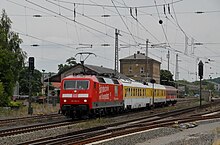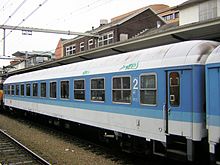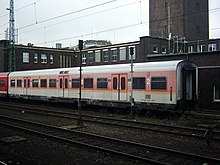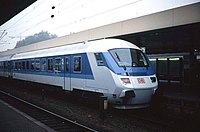Product colors of the Deutsche Bundesbahn

The product colors , more rarely also called product painting or product coloring , were a painting concept introduced in 1986 by the then Deutsche Bundesbahn (DB) for passenger coaches , railcars and locomotives . After German reunification (1990), the design was also transferred to the Deutsche Reichsbahn in the former German Democratic Republic (GDR) and finally taken over in 1994 by the privately organized Deutsche Bahn AG (DB AG). From 1996, the product colors were replaced by traffic red together with light gray (RAL 7035) as a contrasting color as the standard paint for all Deutsche Bahn AG vehicles.
description
The concept of the product colors provided for a group of train types , a " product family ", to be assigned an independent identification color, with pastel colors dominating in line with the zeitgeist of the time :
| InterCityExpress (ICE), from 1991: | wide decorative stripe in oriental red ( RAL 3031), narrow decorative stripe in pastel violet (RAL 4009) |
| InterCity (IC), Eurocity (EC) and saloon cars : | Window strip oriental red (RAL 3031), accompanying strips pastel violet (RAL 4009) |
| InterRegio (IR), FernExpress (FD), InterCityNight (ICN), social coaches and motorail coaches : | Window strip distant blue (RAL 5023), guard stripes pastel blue (RAL 5024) |
| City-Bahn (CB), RegionalBahn (RB) and RegionalSchnellBahn (RSB), from 1994 also RegionalExpress (RE) and StadtExpress (SE): | Window strip mint turquoise (RAL 6033), accompanying strips pastel turquoise (RAL 6034) |
| S-Bahn (S) Frankfurt , Munich , Nuremberg , Rhine-Ruhr and Stuttgart : | Window strip salmon orange (RAL 2012), accompanying strips pastel yellow (RAL 1034) |
| Locomotives, except those of the Nuremberg S-Bahn and the Rhein-Ruhr S-Bahn : | Oriental red (RAL 3031), with a white contrasting surface in the form of a bib on the front |
- In contrast, the following areas were the same for all cars:
- Car body below, solebar and car roof on the side ( haunches ): light gray (RAL 7035)
- Car roof above: initially light gray (RAL 7035), later from around 1989 window gray (RAL 7040); Exceptions: on the ICE light gray, on some cars with a roof made of stainless steel , this was unpainted
- Window frame: window gray (RAL 7040)
- Entrance doors from the inside: oriental red (RAL 3031), except for the ICE
- Bogies and aprons: gray brown (RAL 8019); Exception: for ICE quartz gray (RAL 7039)
- the accompanying strip below the window band was usually 26 centimeters wide, only on the S-Bahn vehicles and the Talgo night trains it was significantly narrower
- The first car class was only marked with an additional stripe below the roof edge for local and S-Bahn cars, this was traffic yellow (RAL 1023)
- Due to their design, the motorail coaches were painted completely in distant blue
- The InterRegio buses were painted in the same colors as the trains, but had the opposite color scheme
history
In 1984 the design agency Keysselitz was commissioned to redesign the entire corporate design of the Deutsche Bundesbahn. A concept was developed that provided for various combinations of strawberry red, gray white and sapphire blue. The different product families were differentiated by different sequences of these three colors. As an alternative, the DB Design Center developed a color scheme with a uniform base coat in gray-white with a blue-green window band, in which the product families were only differentiated by different decorative stripes. Both schemes were used on a prototype train consisting of a class 111 electric locomotive and four passenger coaches. Both trains were presented on September 23, 1985 at Hockenheim station . The Keysselitz design was judged to be too colorful, while the product differentiation in the design of the design center was too subtle. For a better decision of the product families, the different color designs of the ribbon windows were examined, with the colors red for fast long-distance traffic, blue for long-distance travel, mint green for local traffic and yellow or orange for S-Bahn. Numerous different colors as well as different arrangements and widths of the colored stripes on a scale of 1: 1 were examined in detail on passenger coaches available for this purpose. Variants with strips drawn down to the vehicle frame or up to the lower edge of the roof were also tested. For this purpose, a special color sample was repeatedly created, this consisted of two couchette cars (type Bcm 241 and Bcm 251 , labeled as ABm 241 ) which symbolized the two new colors of long-distance traffic and two n-type cars (type Bnb 719 ) in the two new colors of local transport. The extension of the color scheme developed for the InterCityExperimental with white car bodies and red decorative stripes on passenger coaches was considered, but was rejected as "unsatisfactory" even before the practical color tests on passenger coaches. There were also fears that the new ICE product would be devalued.
The Deutsche Bundesbahn presented the final new color concept to the public on December 10, 1986 in Frankfurt Central Station . Ultimately, none of the four cars ever went into regular service in this paint scheme. The set was pulled by the 111 068-3 locomotive, which was the first machine in the new design. The model railway manufacturers also reacted with the presentation of corresponding innovations at the Nuremberg Toy Fair in 1987. For the colors of the window strip and the strip underneath, the colors of the Wiederhold color table were still used during the presentation , but before the series application this was in the RAL color scheme. Color plate added. The roofs were not only painted light gray (RAL 7035) on the prototypes but also on the first series vehicles. Because this light color was very susceptible to soiling, it was later replaced by window gray (RAL 7040), with a narrow, 20 centimeter wide strip of light gray, the so-called "wash edge", left over the window.
At the same time, the new colors replaced the ivory-ocean-blue color concept from 1974, the pop paintwork from 1969, the ivory-purple Trans-Europ-Express paintwork from 1957 and later all the paintwork variants of the Deutsche Reichsbahn. In the case of the S-Bahn in West Germany, the color scheme changed only slightly compared to the previous pop paint in pure orange / pebble gray. In return, the Deutsche Reichsbahn painted its S-Bahn wagons in a mint turquoise / pastel turquoise / light gray analogue to the regional trains, and the S-Bahn locomotives in the east also received the standard oriental red paint. Furthermore, the ICE series design was largely based on the InterCityExperimental of 1985.
Basically, only new or modernized vehicles were initially given the product colors, which meant that the implementation of the color concept dragged on for many years and ultimately could never be completed. In return, the passengers could already see from the outside that it was a contemporary train. In order to achieve a uniform appearance of the trains more quickly, however, many type Bm 235 compartment cars were soon repainted in the Intercity product colors oriental red / pastel violet / light gray without further modernization measures. In local transport, this applied to three double multiple units of the 628.0 series , which were also given a mint turquoise / pastel turquoise / light gray paintwork without a redesign.
In addition - in accordance with the corporate identity valid at the time - the interior design always corresponded in color to the exterior paintwork. Later, neutrally painted luggage trolleys were added, which - regardless of the type of train - initially had a traffic gray (RAL 7042) window strip and an agate gray (RAL 7038) accompanying strip. In the 1990s, however , mint turquoise / pastel turquoise / light gray luggage trolleys were also used to take bicycles with you on regional trains. There were also some railway service vehicles with dark yellow window strips and light yellow or gray accompanying stripes. The Deutsche Bundesbahn also planned the traffic gray / agate gray design for rail mail cars , while the Deutsche Bundespost preferred the yellow paintwork reserved for rail service vehicles. Because the two state-owned companies could not agree, the post coaches kept their traditional paintwork in chrome oxide green or ivory-ocean blue.
With the modernization and the new color scheme, new types of trains were also introduced. In long-distance traffic, as in many European countries, the Trans-Europ-Express and international Intercity trains were replaced by the EuroCity from 1987 . From 1988 onwards, the InterRegio replaced the remaining express trains in daily traffic on subordinate long-distance routes, mainly in Germany .
In local transport, the traditional express train and local train were replaced by the RegionalSchnellBahn , CityBahn and RegionalBahn . During a transitional period up to around 1994, these new types of train were only valid for trains in regular service with new or modernized vehicles in product colors; unmodernized trains continued to operate under their old name.
The product colors did not have any effect on freight wagons , these remained predominantly painted in RAL 8012 red-brown. The same applied to the rail buses , which kept their raspberry-red paintwork, which was only introduced in the mid-1980s.
With the introduction of the product colors, the signage at the train stations was also revised. The station signs remained white, but were given a distant blue frame and the station name was written in black in upper and lower case in semi-bold Helvetica instead of in capital letters as before in a Futura version .
From the introduction of the product colors, the logo of the Deutsche Bundesbahn was designed in uniform orient red and white, instead of the previous black and white or the color of the vehicle. Orient red logos were sometimes found on vehicles with older colors. As a result of the 1994 rail reform , the new DB AG appeared with a new, simplified logo, but retained the color division introduced in 1986.
Rail vehicles delivered ex works in product colors
All ICE 1 and ICE 2 multiple units were given the color scheme in light gray with a stripe in oriental red / pastel violet ex works.
The entire series of the 120.1 series was painted in oriental red at the factory. The DR procured the class 212 (later designated 112) and one of the four locomotives of the class 252 (later 156) in this color .
The Bvmz 185 cars and part of the Bomz 236 procured for EC / IC trains were delivered in oriental red / pastel violet / light gray.
Another part of the Bomz 236 and the Amz 210 were procured in distant blue / pastel blue / light gray. The Talgo train units for the InterCityNight were also delivered in this color scheme . These remained the only night travel vehicles in product colors; other night trains, if not operated by the City Night Line CNL AG , kept the old color schemes in cobalt blue or ivory / ocean blue in this era.
All multiple units of the series 610 , 611 , 628.2 , 628.4 and 628.9 / 629 were delivered in the local transport colors mint turquoise / pastel turquoise / light gray. This also affected the double-decker cars of the 1992 to 1997 series, these are the control cars DABbuzf 760 , DBbzf 761 and DABpbzf 762 as well as the intermediate cars DBz 750 , DB (p) z 751 , DABz 755 and DAB (p) z 756 .
The seventh and eighth series of the 420 series delivered from 1989 , with the exception of the six trains 425 to 430 in the pastel blue Munich Airport Express design, as well as the second, third and fourth series of the x-cars , carried the S-Bahn from the start -Colors salmon orange / pastel orange / light gray.
Conversion programs in product colors
During the product color era, the DB and DR undertook several programs to modernize their passenger coaches and railcars.
The wagons for EuroCity / InterCity traffic, including the former TEE and Eurofima wagons, were newly painted in oriental red / pastel violet / light gray from 1987 onwards and some of them were pressurized . The color scheme of the interior has been updated. Former WRbumz 139 quick-pick dining cars have been converted into WRmz 137 on-board restaurants and painted in product colors.
From 1995 onwards, Bimdzf 269 control cars were built from DR cars for long-distance push -pull trains , some of which were painted in IC colors. To connect Wiesbaden to the Intercity system, Linke-Hofmann-Busch converted the prototypes of local transport vehicles for the Wiesbaden-City short-haul IC and painted them in oriental red / pastel violet / light gray. Another part of the Bimdzf 269 control car was intended for IR use and was painted accordingly.
Most of the wagons in the colors distant blue / pastel blue / light gray of the other long-distance traffic were the UIC-X wagons of the DB and the UIC-Z wagons of the DR that had been converted for the InterRegio .
Numerous n-wagons , Halberstadt center entry wagons and double-decker wagons of the DR were modernized and were given the local transport colors mint turquoise / pastel turquoise / light gray. In the case of diesel multiple units , this affected the series 614 , 624/634 and 771/772 . Individual vehicles of the 798 series were modernized and repainted for the Chiemgau Railway.
See also
Web links
- Description of the product colors on trix.de , accessed on August 25, 2018.
Individual evidence
- ^ A b c d e Karl-Dieter Bodack: InterRegio - The adventurous story of a popular train system . EK-Verlag, Freiburg 2005, ISBN 3-88255-149-6 , p. 31-34 .
- ↑ a b c d Dietrich Neidhardt: New colors for the vehicles of the Deutsche Bundesbahn . In: The Federal Railroad . tape 61 , no. 3 . Hestra-Verlag, Darmstadt March 1987, p. 205-216 .
- ↑ a b c d e f Wolfgang Diener: Painting and designation of motor coaches and passenger coaches . VGB Verlagsgruppe Bahn, Fürstenfeldbruck 2014, ISBN 978-3-8375-1160-4 , p. 92-105 .
- ↑ a b Ernst Andreas Weigert: Bvmz 185 . In: The German passenger and freight cars . EK-Verlag, Freiburg May 2004, supplementary delivery 9.
- ↑ Vehicle color schemes on bahnstatistik.de , accessed on August 25, 2018.
- ↑ a b c d Michael Dostal: Color scheme for passenger coaches - Deutsche Bundesbahn between 1985 and 1997 . In: Wagen - The archive of German passenger and freight cars . GeraNova Zeitschriftenverlag, Munich 1999, supplementary delivery 8.
- ↑ Michael Meinhold: "Red is great, green is problematic" ; MIBA 1/87, p. 11.
- ↑ Karlheinz Oechsler: Caution! Freshly painted! The DB in a new color scheme ; MIBA 9/87, pp. 32-36.
- ^ Fair report from Nuremberg ; MIBA 3/87 and MIBA 3a / 87.
- ↑ Diener, pp. 105-107.












